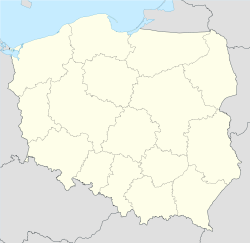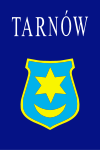Tarnów
| Tarnów | |||
|
|
|||
|
|||
 Tarnów
|
|||
| Coordinates: | |||
| Country | |||
|---|---|---|---|
| Voivodeship | Lesser Poland | ||
| County | city county | ||
| Town rights | 1330 | ||
| Government | |||
| - Mayor | Ryszard Ścigała | ||
| Area | |||
| - Total | 72.4 km² (28 sq mi) | ||
| Population (2006) | |||
| - Total | 117,109 | ||
| - Density | 1,617.5/km² (4,189.4/sq mi) | ||
| Time zone | CET (UTC+1) | ||
| - Summer (DST) | CEST (UTC+2) | ||
| Postal code | 33-100 to 33-110 | ||
| Area code(s) | +48 014 | ||
| Car plates | KT | ||
| Website: http://www.tarnow.pl | |||
Tarnów [ˈtarnuf] (![]() listen) (German: Tarnau; Yiddish: טארנא-Turna) is a city in southeastern Poland with 118,128 inhabitants (2006).
listen) (German: Tarnau; Yiddish: טארנא-Turna) is a city in southeastern Poland with 118,128 inhabitants (2006).
The city has been situated in the Lesser Poland Voivodeship since 1999, but from 1975 to 1998 it was the capital of the Tarnów Voivodeship. It is a major rail junction, located on the strategic east-west connection from Lviv to Kraków. Also, from Tarnów two additional lines stem - a southwards main line to the Slovakian border via Stróże, as well as a minor northwards line to Szczucin (now defunct).
Contents |
History
The first recorded mention of the city was in 1224. It gained city rights on March 7, 1330. In the 13th century, numerous German settlers immigrated from Kraków and Nowy Sącz. During the 16th century Scottish immigrants began to come in large numbers (Dun, Huyson and Nikielson). It was annexed by Habsburg Austria in 1772 during the First Partition of Poland. The Diocese of Tarnów was formed in 1785.
During World War I, the city was one of the focal points of Austro-Hungarian/German Gorlice-Tarnów Offensive of 1915, a military operation that changed the situation in the Eastern Front and resulted in major retreat of opposing Russian forces. After the war, the city became part of a reconstituted Polish state on October 30, 1918.
The Jews of Tarnów
Before World War II, about 25,000 Jews lived in Tarnów. Jews, whose recorded presence in the town went back to the mid-fifteenth century, comprised about half of the town's total population. A large portion of Jewish business in Tarnów was devoted to garment and hat manufacturing. The Jewish community was ideologically diverse and included both religious Hasidim and secular Zionists.
Immediately following the German occupation of the city on September 8, 1939, the persecution of the Jews began. German units burned down most of the city's synagogues on September 9 and drafted Jews for forced-labor projects. Tarnów was incorporated into the Generalgouvernement. Many Tarnów Jews fled to the east, while a large influx of refugees from elsewhere in Poland continued to increase the town's Jewish population. In early November, the Germans ordered the establishment of a Jewish council (Judenrat) to transmit orders and regulations to the Jewish community. Among the duties of the Jewish council were enforcement of special taxation on the community and providing workers for forced labor.
During 1941, life for the Jews of Tarnów became increasingly precarious. The Germans imposed a large collective fine on the community. Jews were required to hand in their valuables. Roundups for labor became more frequent and killings became more commonplace and arbitrary. Deportations from Tarnów began in June 1942, when about 13,500 Jews were sent to the Belzec extermination camp. During the deportation operations, German SS and police forces massacred hundreds of Jews in the streets, in the marketplace, in the Jewish cemetery, and in the woods outside the town.
After the June deportations, the Germans ordered the surviving Jews in Tarnów, along with thousands of Jews from neighboring towns, into a ghetto. The ghetto was surrounded by a high wooden fence. Living conditions in the ghetto were poor, marked by severe food shortages, a lack of sanitary facilities, and a forced-labor regimen in factories and workshops producing goods for the German war industry.
In September 1942, the Germans ordered all ghetto residents to report at Targowica Square, where they were subjected to a "Selektion" (selection) in which those deemed "unessential" were selected out for deportation to Belzec. About 8,000 people were deported. Thereafter, deportations from Tarnów to extermination camps continued sporadically; the Germans deported a group of 2,500 in November 1942.
In the midst of the 1942 deportations, some Jews in Tarnów organized a Jewish resistance movement. Many of the resistance leaders were young Zionists involved in the Ha-Shomer Ha-Tsa'ir youth movement. Many of those who left the ghetto to join the partisans fighting in the forests later fell in battle with SS units. Other resisters sought to establish escape routes to Hungary, but with limited success.
The Germans decided to destroy the Tarnów ghetto in September 1943. The surviving 10,000 Jews were deported, 7,000 of them to Auschwitz and 3,000 to the Plaszow concentration camp in Kraków. In late 1943, Tarnów was declared "free of Jews" (Judenrein). By the end of the war, the overwhelming majority of Tarnów Jews had been murdered by the Germans. Although 700 Jews returned in 1945, some of them soon left the city.
Climate
Called 'Poland's warmest place' Tarnów has the highest annual mean temperature in the country at 8.6°C. The average temperature in January is -4.7°C and 19.3°C in July. [1], It is claimed, Tarnów has the longest summer in Poland spreading from mid May to mid September and it has the shortest winter in Poland.
| Month | Jan | Feb | Mar | Apr | May | Jun | Jul | Aug | Sep | Oct | Nov | Dec | Year |
|---|---|---|---|---|---|---|---|---|---|---|---|---|---|
| Average high °C (°F) | 2 (34) |
5 (37) |
11 (49) |
12 (58) |
18 (71) |
24 (80) |
30 (86) |
31 (88) |
28 (77) |
15 (64) |
10 (52) |
5 (36) |
12 (56) |
| Average low °C (°F) | -5 (24) |
-5 (24) |
-1 (33) |
3 (40) |
9 (51) |
15 (55) |
16 (58) |
18 (57) |
9 (47) |
2 (45) |
0 (33) |
-3 (27) |
4 (41) |
| Precipitation cm (inches) | 2.8 (1.1) |
2.6 (1) |
3 (1.1) |
3.8 (1.3) |
5 (2) |
6.6 (2.3) |
7.6 (2.7) |
7.1 (2.5) |
4.6 (1.8) |
4 (1.6) |
3.8 (1.5) |
3.6 (1.4) |
54.9 (20.6) |
| Source: Weatherbase[2] 2008-07-30 | |||||||||||||
Education
- Małopolska Wyższa Szkoła Ekonomiczna
- Wyższa Szkoła Biznesu
- Państwowa Wyższa Szkoła Zawodowa
Sports
- Unia Tarnów - speedway team, championship of Poland in 2004, 2005. Sponsored by Mościce Nitrate Factory. Also called Jaskółki (Swallows)
- ZKS Unia Tarnów - Zakładowy Klub Sportowy Unia Tarnów (Workplace Sports Club United Tarnów) - Soccer team, currently in the I League in Polska Liga in 2005/2006 season.
- Tarnovia Tarnów - Soccer team, also in II League in Polska Liga in 2005/2006 season.
- Unia Wisła Paged Tarnów - men's basketball team, 6th in Era Basket Liga in 2003/2004 season.
Religion
According to official Church statistics, Tarnów is the most religious city in Poland, with 89.6% of the faithful of the Diocese of Tarnów attending Mass weekly [3].
Politics
Tarnów constituency
Members of Parliament (Sejm) elected from Tarnów constituency:
- Urszula Augustyn, PO
- Edward Czesak, PiS
- Aleksander Grad, PO
- Barbara Marianowska, PiS
- Józef Rojek, PiS
- Wiesław Woda, PSL
- Michał Wojtkiewicz, PiS
Member of the European Parliament
- Urszula Gacek, PO, EPP-ED
Notable residents
- Baron Henry Apfelbaum
- Professor Salo Wittmayer Baron
- Józef Bem
- Mordecai David Brandstädter ([1])
- Roman Brandstaetter
- Józef Cyrankiewicz
- Jacek Dukaj
- Wilhelm Friedrich Wolff, born June 21, 1809, † May 9, 1864 in Manchester, England. Austrian journalist, close friend of Karl Marx
- Ignace J. Gelb/Ignace Gelb (1907-1985)
- Allan Gray (1902-1973), composer
- Michał Heller
- Naphtali Keller (January 25, 1834 - August 5, 1865, Rožnava, Moravia) Jewish scholar; son of Israel Mendel Keller ([2])
- Leon Kellner (1859-), Jewish scholar ([3])
- Krystyna Kuperberg
- Siegfried Lipiner ([4]), Austrian poet
- Anny Ondra (1903-1987), Czech movie star
- Joseph Öttinger (1818 - October 2, 1895), Austrian physician, born May 7, 1818; died at Cracow October 2, 1895 ([5])
- Eustachy Stanisław Sanguszko
- Wilhelm Sasnal
- Spycimir Leliwita
- Jan Tarnowski
- Jan z Tarnowa (c.1349-1409)
- Jan z Tarnowa (1367-1433)
- Rafał z Tarnowa (c. 1330-1373)
- Rabbi Marcus Weissmann-Chajes (1830-), Jewish scholar ([6])
- Rabbi Salo Wittmayer Baron (1895-1989), Jewish historian
- Franciszek Zachara, composer and pianist (1898-1966)
- Dorota Sacha-Krol, PhD, scholar, thinker
- Anna Brzozowska, nee Sacha, PhD
- Sylwia Swierczek-Rodan, artist
- Tony Rickardsson, motorcycle speedway rider, honorable resident (since June 22, 2006)
- Jan Szczepanik, inventor
- Rabbi Löb Judah ben Isaac ([7])
Twin Towns - Sister Cities
Tarnów is twinned with:
See also
- Mościce
- Diocese of Tarnów
- 1939 Tarnow rail station bomb attack
- First mass transport to Auschwitz concentration camp
External links
- City of Tarnów English version of Tarnów's official webpage.
- United States Holocaust Memorial Museum Tarnow
Notes
- ↑ TARNW, Weather History and Climate Data
- ↑ "Weatherbase: Historical Weather for Tarnów, Poland" (in English). Retrieved on July 30, 2008.
- ↑ Tygodnik Katolicki - Gość Niedzielny - Wydanie Internetowe
- This article incorporates text from the United States Holocaust Memorial Museum, and has been released under the GFDL.
|
||||||||||
|
||||||||||||||



